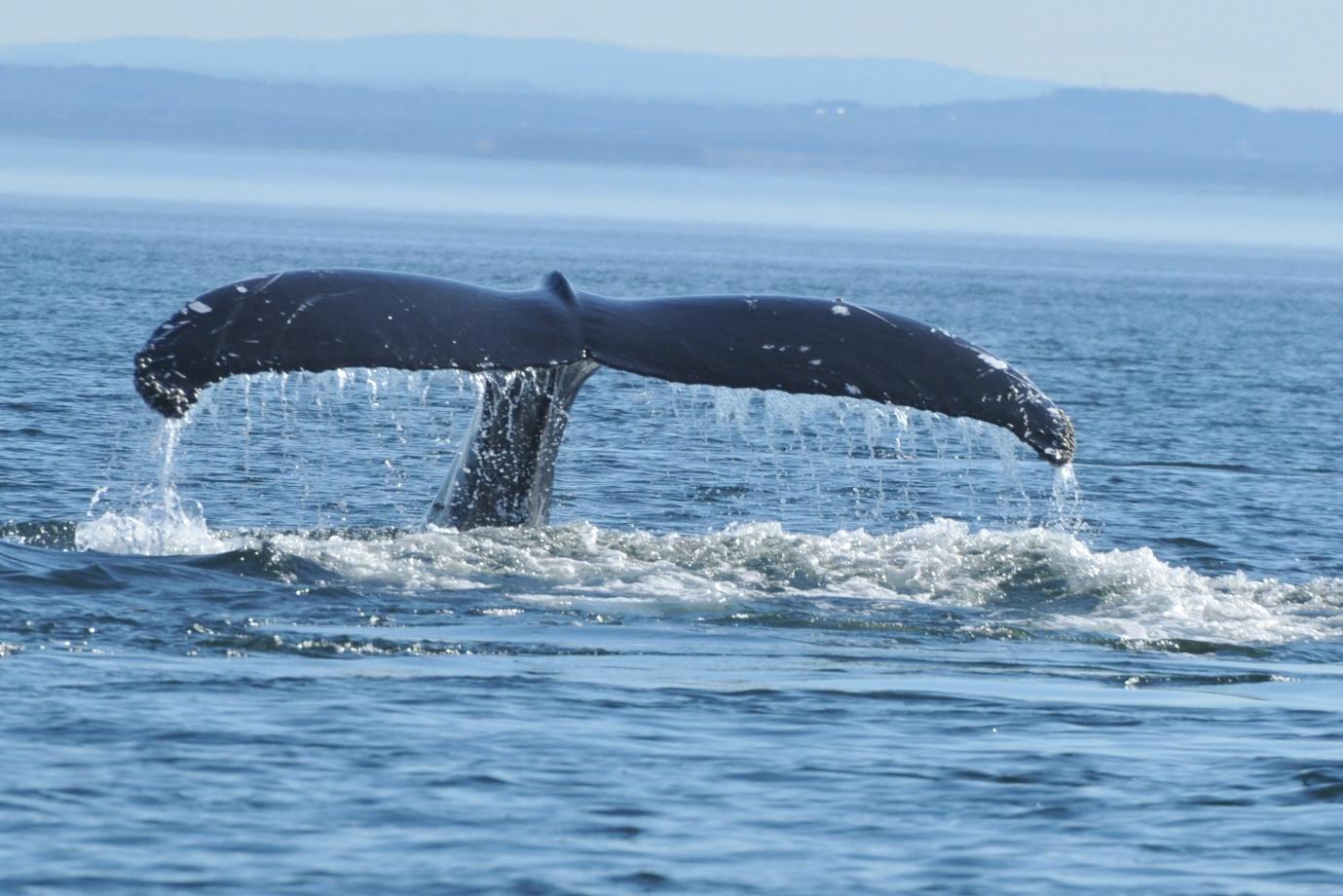A Humpback Tail!
The procedure when we board Stena Europe is to report to
Passengers Reception to let them know we are staying on board because the
computer assumes that we are foot passengers who will disembark in Rosslare. We
then report to the Bridge, introduce ourselves, donate a packet of Welsh Cakes
for the Bridge staff to enjoy, and then go out onto whichever Bridge Wing which
will not be used by the Captain for maneuvering when we depart. We set up our
GPS, cameras, record sheet, and unpack binoculars. During winter surveys hats,
gloves, wooly pulleys etc are donned. Because my DSLR camera complete with
70-300 zoom is quite heavy on the neck particularly when accompanied by
binoculars for the 3 hours of the survey I used to leave it on the bench at the
back of the Bridge Wing.
While doing a survey with Christina we were half way over
when I spotted a pod of very lively common dolphins a little over a mile off
our starboard quarter. I called it and left Christina to count/observe while I
went to pick up my camera. Christina is normally a very calm, methodical young
lady as one would expect of a scientist but as I picked up my camera she
started calling excitedly, very very excitedly,’ Steve! Steve! Steve!!! come
quickly’.
I rushed back fearing some sort of accident but no she had
spotted a humpback in the same direction as the common dolphins. When she
calmed down and explained her sighting she had seen the tail up out of the
water, often done as the animal begins its dive. As the average dive time is 15
minutes and we travel 5 miles in that time we did not see it again although we
really searched that bit of sea. I have done a lot of ferry surveys but have yet
to see a humpback. I have had large mysterious splashes which may have been,
and blows which may have been but none confirmed. I did have some awesome whale
watching in the Gulf of Montreal where I took this tail photo.
Because we always try to survey in calm conditions we run
the risk of fog. Cliff and I are usually verbally jousting and the nickname he
dislikes most is Foggy Benson. On one occasion the Stena Europe was sounding
its fog horn so the survey team went inside the Bridge to get away from the
noise and the survey was suspended. I turned off my hearing aid and stayed on
the Wing. I could only see about 50 metres of sea and the noise was quite
intense but the bit of sea that was visible was mirror flat. Lo and behold! I spotted a leatherback turtle
in that small arc of visibility!
We have had some disastrously foggy surveys but it can
produce occasional photo opportunities. Irish Ferries operate the Isle of
Inishmore from Rosslare to Pembroke Dock and in May 2018 we had this strange
sight. We started seeing just the aerials above the fog and gradually she grew.and grew out of the fog until we could see the whole ship!
When surveying in light winds good clear weather is usual
and it does lead to some spectacular sunsets. Here is a November sunset with
the Tusker Rock lighthouse flashing in the distance.
While surveying for cetaceans we always note interesting
bird activity and while this is secondary to cetaceans it adds interest and is
a useful addition to the CVs of the interns who contribute so much. Sea bird
activity is also often a pointer to cetacean activity. In June 2008 during an
exceptionally calm crossing, Cliff left the port Bridge Wing to see if the
glare from the sun was any less on the starboard wing. He spotted a “subadult gannet'', struggling to take off as
the ship approached it. When it eventually took to flight, skittering along the
surface, the tips of its exceptionally long wings were still beating the
surface. Then it dawned on him... An ALBATROSS. He rushed across and through
the Bridge, shouting Albatross! Albatross! but we failed to find it again. A
few days later an albatross, reported as “probably” a Black Browed Albatross,
was recorded from Ramsey Sound.
(Footnote from “Foggy” Benson… Thanks for that Steve.
Revenge is a dish best served cold...)
The one that got away!
As quite an experienced sea watcher, I have been lucky
enough to encounter several of the sea birds that most birders only dream of.
These include Wilson’s Petrel and Little Shearwater but the third bird of the
British sea birder’s holy trinity had eluded me, the Albatross!If I had my
trusty Canon SX 60 My name would have been in the record books but as a single
observer with no corroborating evidence the chances of it being accepted by the
British Rare Birds Committee were zilch!
Unknown to us at the time, the likelihood was that the bird
was most likely a Yellow Nosed Albatross, a similar looking bird to the Black
Browed which I took it to be. Apart from a few friends I kept quiet about the
bird as I suspected no one would believe my story! It later transpired that at
much the same time as my sighting, A Yellow Nosed Albatross was reliably
reported from off Kristiansund on the coast of Norway. Closer to home. another
was found exhausted on a Bristol Channel beach in Somerset! Another bird turned
up in a Freshwater Lake in Lincolnshire!
for more info...
https://britishbirds.co.uk/wp-content/uploads/2014/05/V103_N07_P376%E2%80%93384_A.pdf


